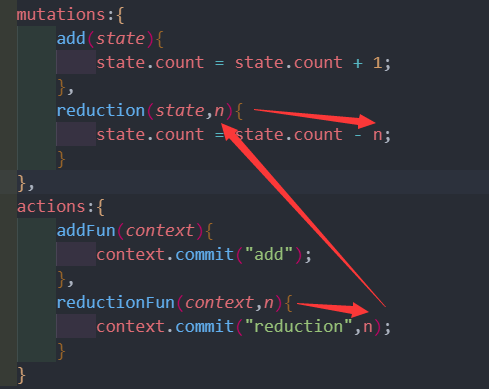一、什么是Vuex
1.Vuex 是一个专为 Vue.js 应用程序开发的状态管理模式。(可以当成全局对象理解。)
2.Vuex 和单纯的全局对象有两点不同:
Vuex 的状态存储是响应式的。
改变 store 中的状态的唯一途径就是显式地提交 (commit) mutation。
3.Vuex的核心是store(仓库),store包含着应用中大部分的状态 (state:组件中的共享状态)。
二、Vuex的安装
在项目根目录终端输入:
npm install vuex --save
在main.js中加入:
import store from './store'//注意是否在src目录下新建store文件目录,并创建store实例
三、Vuex的核心概念
1、State
state 可以看作是所有组件的 data,用于保存所有组件的公共数据。
2、Getters
getters 可以看作是所有组件的 computed 属性,getters 的返回值会根据它的依赖被缓存起来,只有当它的依赖值发生改变才会被重新计算。
3、Mutations
mutations 可以看作是 store 中的 methods,其中保存着更改数据的回调函数。
4、Actions
actions 类似于 mutations,区别在于:
- actions 提交的是 mutations 而非直接变更状态
- actions 中可以包含异步操作,而mutations 中不允许出现异步
5、Modules
由于使用单一状态树,当应用变得非常复杂时,store 对象会变得相当臃肿,Vuex 允许将 store 分割成模块(module)。每个模块拥有自己的 state、mutations、actions、getters、甚至是嵌套子模块——从上至下进行同样方式的分割:
const moduleA = { state: { ... }, mutations: { ... }, actions: { ... }, getters: { ... } } const moduleB = { state: { ... }, mutations: { ... }, actions: { ... } } const store = new Vuex.Store({ modules: { a: moduleA, b: moduleB } }) store.state.a // -> moduleA 的状态 store.state.b // -> moduleB 的状态
四、创建Vuex实例
在项目的src目录下新建一个目录store,在该目录下新建一个index.js文件,然后在该文件中引入vue和vuex,创建Vuex.Store实例保存到变量store中,最后使用export default导出store:
import Vue from 'vue' import Vuex from 'vuex' Vue.use(Vuex); const store = new Vuex.Store({ state: { count: 1 } }); export default store;
五、Vuex获取store数据
<h2>{{this.$store.state.count}}</h2>
六、Vuex获取改变后的store数据(Getters 可用于监听、state中的值的变化)
<h2>我是从Getters中获取的计算后的值:{{this.$store.getters.getStateCount}}</h2>
import Vue from 'vue' import Vuex from 'vuex' Vue.use(Vuex); const store = new Vuex.Store({ state: { count: 1 }, getters:{ getStateCount:function(state){ return state.count+1; } } }); export default store;
七、Vuex修改store数据(mutations)
<template> <div class="hello"> <h2>{{this.$store.state.count}}</h2> <button @click="addFun">+</button> <button @click="reductionFun">-</button> </div> </template> <script> export default { name: 'HelloWorld', methods:{ addFun(){ this.$store.commit('add'); }, reductionFun(){ this.$store.commit('reduction'); } } } </script>
在mutations中定义的两个函数主要是用来修改count的值:
import Vue from 'vue' import Vuex from 'vuex' Vue.use(Vuex); const store = new Vuex.Store({ state: { count: 1 }, getters:{ getStateCount:function(state){ return state.count+1; } }, mutations:{ add(state){ state.count = state.count + 1; }, reduction(state){ state.count = state.count - 1; } } }); export default store;
到此,操作运行页面,点击+、- 按钮操作查看数据是否改变。
上面我们的操作虽然值改变了,但是官方并不建议我们直接去修改store里面的值,而是让我们去提交一个actions,在actions中提交mutation再去修改状态值,接下来我们修改index.js文件,先定义actions提交mutation的函数:
import Vue from 'vue' import Vuex from 'vuex' Vue.use(Vuex); const store = new Vuex.Store({ state: { count: 1 }, getters:{ getStateCount:function(state){ return state.count+1; } }, mutations:{ add(state){ state.count = state.count + 1; }, reduction(state,n){ state.count = state.count - n; } }, actions:{ addFun(context){ context.commit("add"); }, reductionFun(context,n){ context.commit("reduction",n); } } }); export default store;
然后我们去修改Hello World.vue文件:
<template> <div class="hello"> <!-- <h2>我是从页面上直接获取的:{{count1}}</h2> --> <h2>{{this.$store.state.count}}</h2> <button @click="addFun">+</button> <button @click="reductionFun">-</button> </div> </template> <script> export default { name: 'HelloWorld', data () { return { } }, methods:{ addFun(){ this.$store.dispatch('addFun'); }, reductionFun(){this.$store.dispatch('reductionFun'); } } } </script>
这里我们把commit提交mutations修改为使用dispatch来提交actions;我们点击页面,效果是一样的。
好了,我们这里已经实现了一个基本的vuex修改状态值的完整流程,如果我们需要指定加减的数值,那么我们直接传入dispatch中的第二个参数,然后在actions中的对应函数中接受参数在传递给mutations中的函数进行计算:
let n = 10; this.$store.dispatch('reductionFun',n);

这个时候我们再去点击“ - ”按钮就会发现不再是减1了,而是减去10了。